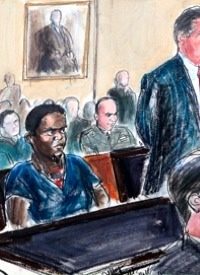
The case involves terrorism suspect Ahmed Ghailani, who was held without trial for five years after being captured in a gun battle in July 2004. Ghailani is charged with providing components for the bombings of two African embassies in 1998. He was recently transferred from Guantanamo for criminal prosecution by the Obama administration. The defense lawyers are attempting to use documentation of the torture Ghailani undoubtedly endured as an argument for leniency in sentencing; the district attorney has announced plans to seek the death penalty.
The court ruled: “Providing the public with access to the charges levied against these detainees … ensures greater oversight of the detentions and these proceedings. As long as public access does not come at the expense of the litigation interest of [the detainees] or national security, the Court believes the public has a … right to access the returns.”
The evidence that Ghailani assisted in the embassy bombings that resulted in the death of 224 people seems overwhelming. At his military commission “trial” (later invalidated as unconstitutional by the U.S. Supreme Court), Ghailani played dumb by saying he didn’t know that he was helping to make bombs.
But Ghailani’s experience early in his detainment at one or more of the CIA secret prisons, called “black sites,” has made him a character of international interest. He was one of the 14 “high value detainees” transferred to Guantanamo whose treatment was covered in a February 2007 International Committee of the Red Cross (ICRC) report. The report was kept confidential until published on the web by the New York Review of Books in April 2009.
The report concluded that some of the worst torture of detainees occurred in those black sites, with the Red Cross concluding “the ICRC clearly considers that the allegations of the fourteen include descriptions of treatment and interrogations techniques – singly or in combination – that amounted to torture and/or cruel, inhuman or degrading treatment.”
Among the most disturbing aspects of the torture sessions (and any honest person would readily admit to calling them torture) was the malicious role medical professionals played in the torture regime. Doctors and other medical personnel were used not to mitigate pain or danger, as the Hippocratic Oath requires, but to maximize pain and discomfort without provoking death or permanent visible scars. Or perhaps it could be more aptly put that the role of doctors under the Bush torture regime was to maximize the torture while minimizing the evidence — and subsequent political fallout — of the torture.
Ironically, this is the argument most often seized upon by those who defened the Bush administration’s torture policy: waterboarding and other torture techniques could not be torture because they were carefully supervised by doctors and other medical personnel. However, in the case of torture techniques that cause life-threatening conditions such as hypothermia, swelling, or drowning, the doctors’ specific role is to bring the detainees to the edge of death (without going over the edge) again and again, and then to bring the detainees back from the brink of death.
In the effort to eliminate the physical evidence, medical professionals supervising torture were not always successful. At least 112 detainees died in detention, many from homicide or other suspicious causes. One of the tortures employed by the Bush administration, copied exactingly from old Soviet and Chinese communist torture practices, involved shackling a prisoner to the ceiling for a prolonged period of time, forcing him to remain standing. The effects of this torture are documented by Mark Danner in his valuable review of the ICRC report: “After 18 to 24 hours of continuous standing, there is an accumulation of fluid in the tissues of the legs. This dependent edema is produced by the extravasation of fluid from the blood vessels. The ankles and feet of the prisoner swell to twice their normal circumference. The edema may rise up the legs as high as the middle of the thighs. The skin becomes tense and intensely painful. Large blisters develop, which break and exude watery serum.”
The swelling of the legs makes shackles detainees claimed they were forced to wear around their ankles cut into the flesh. Red Cross inspectors were able to verify much of one detainee’s (Abu Zubaydah) allegations by looking at the scars on his legs: “Scars consistent with this allegation were visible on both wrists as well as on both ankles,” the ICRC report noted.
In another instance, the ICRC report notes that detainee Bin Attash “alleged that while being held in a form of stress standing position with his arms shackled above his head, and his feet touching the floor, had his lower leg measured on a daily basis with a tape measure by a person he assumed to be a doctor for signs of swelling; the health person finally ordered that he be allowed to sit on the floor, albeit with his arms still shackled above his head.” Another detainee, Hambali (Riduan Isamuddin), described a much more telling encounter with the torture doctors: “after a period of prolonged stress standing, a health person intervened to prevent further use of the method, but told him that ‘I look after your body only because we need you for information.’”
The Red Cross report concluded that “there was a direct role in monitoring the ongoing ill-treatment which, in some instances, involved the health personnel directly participating while certain methods were used.”
Ahmed Ghailani may be a vicious terrorist, but these techniques were performed exclusively upon people who have not faced trial. And many of the detainees at Guantanamo and elsewhere who suffered these tortures later proved to be innocent because of cases of mistaken identity or greedy bounty hunters who defrauded the U.S. government. If Ghailani’s criminal case can expose the inhumanity that was imparted upon other human beings in our name, then this element of the criminal case will have accomplished a worthy goal.
Courtroom sketch of Ahmed Ghailani: AP Images



